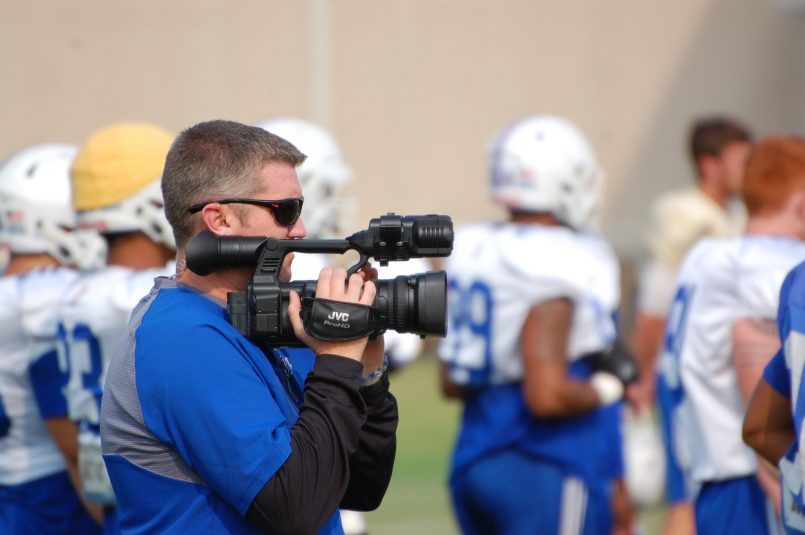University of Tulsa Improves Coaching Video Ops with JVC GY-HM650SC ProHD Camera
Story Highlights
On the playing field, The University of Tulsa (TU) Golden Hurricane began its football season Aug. 31 against the Oklahoma State Cowboys. However, work began on the practice field Aug. 1, and the team has enjoyed improved workflow for its video coaching efforts with its new JVC GY-HM650SC ProHD sports coaching camera.

The University of Tulsa is using the JVC GY-HM650SC camera to shoot football practices and coaching video during games.
TU purchased the GY-HM650SC this summer because of its seamless integration with the XOS Thunder HD video editing platform. The camera has worked so well there are plans to upgrade more cameras to JVC for next season.
Seven students work with DJ Welte, director of football video operations, to produce video footage for practices and games. On game day, Welte and his crew collect footage using three cameras at home or two cameras on the road. Practice footage, however, is more extensive.
Up to six cameras are used to record practice, with the new GY-HM650SC used on the ground as a handheld camera for various drills. Other cameras are positioned in towers in the end zones and two in towers on the sidelines. An action camera is mounted on a pole and held about 11 yards behind the offensive line.
“Our main priority is shooting practice footage and game footage for our coaches and student athletes to review,” explains Welte. “We’ve been pretty impressed so far with the JVC. The images we get out of it are very crisp. You can really see the difference between the JVC and our other cameras.”
Welte estimated the Golden Hurricane can run close to 250 plays during its two-hour practice – and since every play is covered with multiple cameras, his team routinely sorts up to 800 plays after practice. When he ingests footage from other cameras to the server, footage has to be merged and reformatted. In contrast, the GY-HM650SC records in the Sports Exchange Standard, so adding the file to the server is a simple drag-and-drop process.
“The main benefit of the JVC camera is the ingest time. It’s done most of the work for you,” Welte adds. “When you take out that merging and formatting process, it speeds you up quite a bit.”
Another advantage with the GY-HM650SC is the ability to “label” plays in real time. With footage from other cameras, the editor has to open each file and add ODK (offense, defense, kicking) information, which is necessary for coaches and players to efficiently sort and review footage. The GY-HM650SC camera operator, however, can use an iPad to input ODK values in the metadata as soon as the play is over, which “saves the editor a ton of time,” according to Welte. “I spend 10 minutes per quarter doing that per camera.”
Earlier this year, JVC introduced the GY-HM660SC, an upgrade to the GY-HM650SC. Its flexible streaming capabilities allows footage to be sent directly to the XOS Thunder HD as a stream or FTP upload after each play, eliminating the need for manual upload. With its built-in GPS capability, the GY‑HM660SC can also embed a real-time universal time (UTC) reference within the video metadata, which allows a coach to synchronize multiple cameras or instantly locate a video clip associated with specific biometric or positional data collected by player tracking devices.
Beyond streaming and XOS integration, the GY-HM660SC features three upgraded 12-bit CMOS sensors for improved sensitivity, integrated Fujinon wide angle 23x zoom lens, XLR audio inputs and built-in stereo microphone, and two channels of IFB. High-quality HD footage can be recorded to SDHC or SDXC media cards using multiple native file formats and bit rates.
